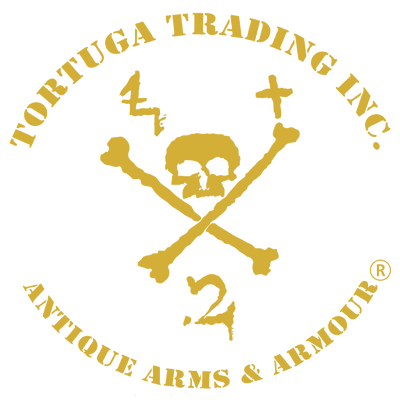A Fantastic & RARE Spanish Bronze Bell from an unidentified Shipwreck Dated 1698 !!!
A Fantastic & RARE Antique Spanish Bronze Bell From an Unidentified Shipwreck Dated 1698 !!! Iron clapper is missing. The bell exhibits evidence of being excavated from the saltwater and has a very pleasing green-brown age patina. The suspension "crown" section is missing and appears to have been broken off when the ship foundered. The bell exhibits removal of most of the marine growth with remnants of coral in protected areas. The surfaces exhibit a cleaned surface with dents and scratches throughout. It has a 4" crack on one side. There are chips missing from the lower periphery edge. This size of bell was designed for use on a ship or in a Spanish Mission but most importantly, the missionaries were tasked by the Church to spread the word and convert as many people in the New World as possible.
The bell was cast with the following raised markings:
On the top appears to be: in Latin "SANTE MICAxx ORA PRO NOBIS ANO 1698", translates to "SAINT MICHAEL PRAY FOR US YEAR 1698.”
On the middle section: a stylized "Cross"
Overall Measures - 9" high, almost 9.5" in diameter.
Note; Dated bronze bells are highly sought after. I have only seen a few bronze bells dated 1698 !!!
PROVENANCE: Unfortunately, no provenance.
SOME HISTORY: "I H S" ROMAN CATHOLIC CHURCH.
The New World- Catholics and the Colonies
Efforts to set up a permanent settlement by the Spanish in the 16th century were mostly unfruitful, until French Huguenots threatened their trade routes by settling at the St. John’s River in modern day Jacksonville at Fort Caroline. Almost immediately after the Spanish founded St. Augustine and massacred their French rivals at Fort Caroline, Spanish priests were starting Indian missions. The first Indian mission was founded by a secular priest, Sebastian Montero from 1566-1572. Spreading Catholicism to Native American groups was a critical mission for the first Spanish settlers. By attempting to spread their Catholic religion to Native groups from the start of colonization, these Spanish settlers and priests were trying to secure their religion’s success in the New World.
Jesuit priests were chosen early on by Florida’s governors to missionize the surrounding Native American groups; however, these efforts were unsuccessful because of Native opposition. By 1595 Franciscan friars replaced the unsuccessful Jesuits and established missions along the Florida coast and north into Georgia. These missions were funded by the Spanish government, however these Catholic missionaries at times protested the treatment of Native Americans by civil authorities. With relative success in the Florida area, missions spread to Texas, New Mexico, and California with varying degrees of accomplishment converting Native American groups throughout the Spanish colonial period.
French Catholics also settled in the New World on Maine’s Scoodic River in 1604. French missionaries also missionized to Native Americans, particularly to tribes in their Northern territories. French missionaries converted the entire Abanaki tribe of Native Americans. The French blended conversion with economic partnerships to use Native groups as allies against the encroaching English settlement in colonial North America.
Unlike the French and Spanish settlements in North America, the British colonists were mostly Protestant and very weary of Catholicism. Catholics did however find their way to the colonies in the 17th century, most notably in Maryland and Pennsylvania, where they found a relative degree of freedom to worship. Because of the Catholic religion of the Spanish and French, Catholicism’s perceived ties to a distant papal ruler, and warfare between Catholics and Protestants in England, many British colonists felt uneasy accepting Catholics into British colonial society.
The Catholic Church during the Age of Discovery inaugurated a major effort to spread Christianity in the New World and to convert the indigenous peoples of the Americas and other indigenous people by any means necessary. Catholicism was introduced to the English colonies in 1634 with the founding of the Province of Maryland by Cecil Calvert, 2nd Baron Baltimore, based on a charter granted to his father George Calvert, 1st Baron Baltimore.
TTI-567922


















